MGT559: Navigating Org Challenges with Ethical Leadership
VerifiedAdded on 2023/05/30
|9
|4947
|282
Report
AI Summary
This report explores the application of ethical and ecosystem leadership approaches in addressing contemporary challenges faced by organizations, particularly within the Australian Public Service (APS). It begins by defining ethics, morals, integrity, and hypocrisy, emphasizing the importance of distinguishing between personal values and ethical values. The report discusses five sources of ethical standards: utilitarian, rights, fairness/justice, common good, and virtue. It also considers rationalizations that individuals use to justify unethical actions and highlights the role of emotions in ethical decision-making. The author draws a distinction between ethical dilemmas and moral temptations, asserting that ethical dilemmas involve balancing conflicting values, such as truth versus loyalty or individual versus community. The report uses examples adapted from Kidder to illustrate these dilemmas, emphasizing that there are often no right or wrong answers but rather a need to make informed decisions along a continuum, while also considering the impact of those decisions on various stakeholders. Desklib provides students with access to a variety of resources, including past papers and solved assignments.
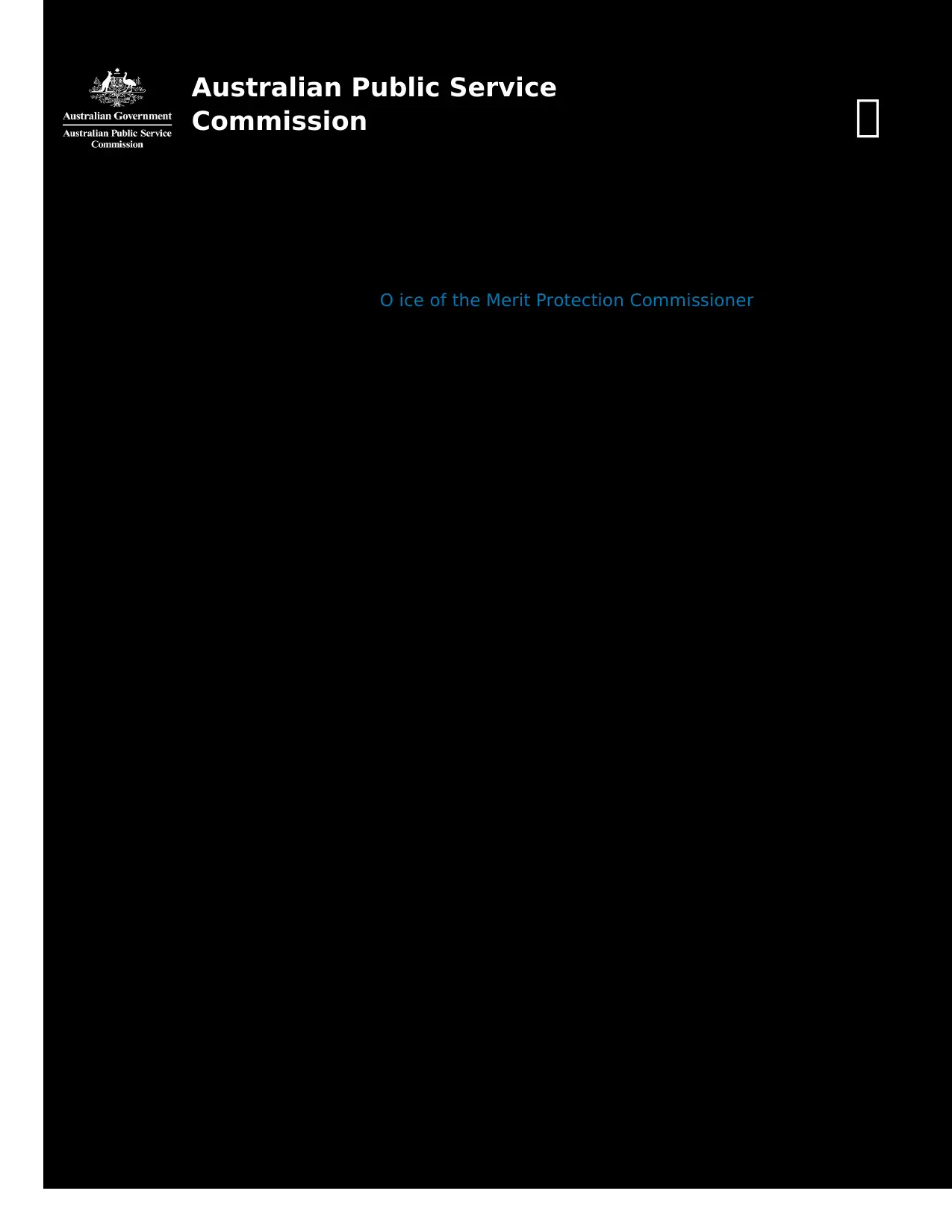
Ethical decision making
Document information:
This document was prepared by the O ice of the Merit Protection Commissioner.
(This page has also been released as The Merit Protection Commissioner and ethical decision making)
Annwyn Godwin
Merit Protection Commissioner
Thank you for inviting me to speak to you today on the very important and topical issue of ‘The Merit
Protection Commissioner and Ethical Decision Making’. I have been asked to be bold and provocative a
provide an approach that will challenge your traditional way of thinking about ethics. These are high
expectations that I will do my best to fulfil and I do hope that you leave this session with a dierent perspective
on some of the ‘ethical’ issues currently facing the Australian Public Service (APS).
It is a very exciting time to be the Merit Protection Commissioner (MPCr) and it coincides neatly with th
Government’s commitment to enhancing the integrity of the APS. For those of you who need a little re
about my role, the O ice of the Merit Protection Commissioner is an independent statutory position
established under section 49 of the Public Service Act. It provides an independent, impartial and profe
scheme for statutory reviews of action;
merit based, non-appealable recruitment services;
other related services; and
supports adherence to the APS Code of Conduct.
In providing these services, I seek to:
advocate a proactive, preventative approach that encourages ongoing, transparent and timely
communication as the basis for positive, respectful and professional working relationships; and
balance the rights and responsibilities of the individual, the organisation and the wider APS through
consistent application of principles of merit and procedural fairness to employment-related decisions
This approach to the work of the MPCr is consistent with the explanatory memoranda that accompanie
Public Service Act 1999 and is put into practice through the Public Service Regulations and the Public S
Commissioner’s directions. That is, wherever possible to deal with a matter as it arises or in as timely a
as possible; to be open to alternative positions and let everyone have a chance to have their say; and,
people informed and provide feedback.
As you can see, my role fits very nicely with the Government’s integrity agenda and in particular those
the heading of ‘separate roles and responsibilities of Government and the public service’ through:
greater transparency in decision making by Government and the public service;
improving ethical advice for public service decision making; and
Australian Public Service
Commission
1
Document information:
This document was prepared by the O ice of the Merit Protection Commissioner.
(This page has also been released as The Merit Protection Commissioner and ethical decision making)
Annwyn Godwin
Merit Protection Commissioner
Thank you for inviting me to speak to you today on the very important and topical issue of ‘The Merit
Protection Commissioner and Ethical Decision Making’. I have been asked to be bold and provocative a
provide an approach that will challenge your traditional way of thinking about ethics. These are high
expectations that I will do my best to fulfil and I do hope that you leave this session with a dierent perspective
on some of the ‘ethical’ issues currently facing the Australian Public Service (APS).
It is a very exciting time to be the Merit Protection Commissioner (MPCr) and it coincides neatly with th
Government’s commitment to enhancing the integrity of the APS. For those of you who need a little re
about my role, the O ice of the Merit Protection Commissioner is an independent statutory position
established under section 49 of the Public Service Act. It provides an independent, impartial and profe
scheme for statutory reviews of action;
merit based, non-appealable recruitment services;
other related services; and
supports adherence to the APS Code of Conduct.
In providing these services, I seek to:
advocate a proactive, preventative approach that encourages ongoing, transparent and timely
communication as the basis for positive, respectful and professional working relationships; and
balance the rights and responsibilities of the individual, the organisation and the wider APS through
consistent application of principles of merit and procedural fairness to employment-related decisions
This approach to the work of the MPCr is consistent with the explanatory memoranda that accompanie
Public Service Act 1999 and is put into practice through the Public Service Regulations and the Public S
Commissioner’s directions. That is, wherever possible to deal with a matter as it arises or in as timely a
as possible; to be open to alternative positions and let everyone have a chance to have their say; and,
people informed and provide feedback.
As you can see, my role fits very nicely with the Government’s integrity agenda and in particular those
the heading of ‘separate roles and responsibilities of Government and the public service’ through:
greater transparency in decision making by Government and the public service;
improving ethical advice for public service decision making; and
Australian Public Service
Commission
1
Paraphrase This Document
Need a fresh take? Get an instant paraphrase of this document with our AI Paraphraser
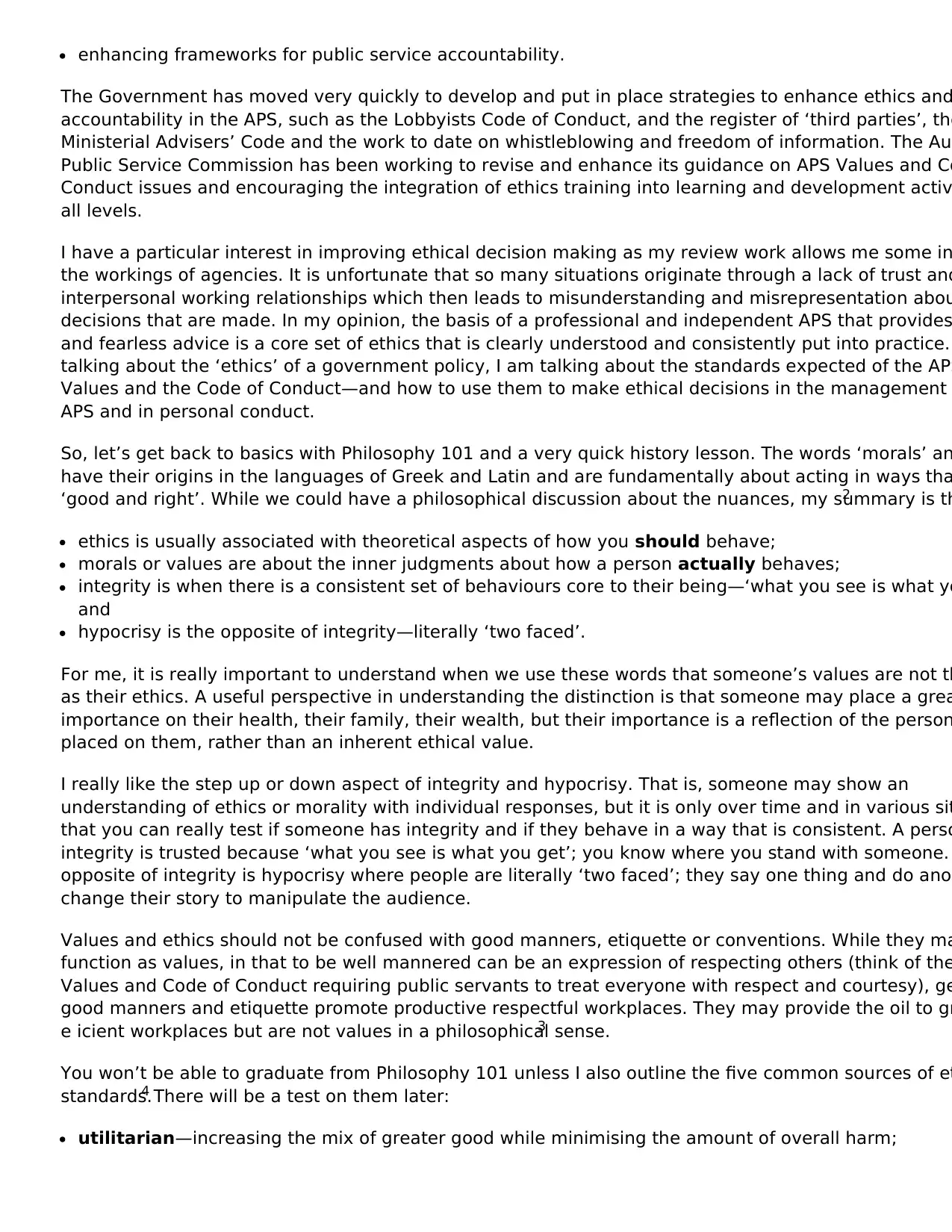
enhancing frameworks for public service accountability.
The Government has moved very quickly to develop and put in place strategies to enhance ethics and
accountability in the APS, such as the Lobbyists Code of Conduct, and the register of ‘third parties’, the
Ministerial Advisers’ Code and the work to date on whistleblowing and freedom of information. The Aus
Public Service Commission has been working to revise and enhance its guidance on APS Values and Co
Conduct issues and encouraging the integration of ethics training into learning and development activ
all levels.
I have a particular interest in improving ethical decision making as my review work allows me some in
the workings of agencies. It is unfortunate that so many situations originate through a lack of trust and
interpersonal working relationships which then leads to misunderstanding and misrepresentation abou
decisions that are made. In my opinion, the basis of a professional and independent APS that provides
and fearless advice is a core set of ethics that is clearly understood and consistently put into practice.
talking about the ‘ethics’ of a government policy, I am talking about the standards expected of the APS
Values and the Code of Conduct—and how to use them to make ethical decisions in the management
APS and in personal conduct.
So, let’s get back to basics with Philosophy 101 and a very quick history lesson. The words ‘morals’ an
have their origins in the languages of Greek and Latin and are fundamentally about acting in ways tha
‘good and right’. While we could have a philosophical discussion about the nuances, my summary is th
ethics is usually associated with theoretical aspects of how you should behave;
morals or values are about the inner judgments about how a person actually behaves;
integrity is when there is a consistent set of behaviours core to their being—‘what you see is what yo
and
hypocrisy is the opposite of integrity—literally ‘two faced’.
For me, it is really important to understand when we use these words that someone’s values are not th
as their ethics. A useful perspective in understanding the distinction is that someone may place a grea
importance on their health, their family, their wealth, but their importance is a reflection of the person
placed on them, rather than an inherent ethical value.
I really like the step up or down aspect of integrity and hypocrisy. That is, someone may show an
understanding of ethics or morality with individual responses, but it is only over time and in various sit
that you can really test if someone has integrity and if they behave in a way that is consistent. A perso
integrity is trusted because ‘what you see is what you get’; you know where you stand with someone.
opposite of integrity is hypocrisy where people are literally ‘two faced’; they say one thing and do anot
change their story to manipulate the audience.
Values and ethics should not be confused with good manners, etiquette or conventions. While they ma
function as values, in that to be well mannered can be an expression of respecting others (think of the
Values and Code of Conduct requiring public servants to treat everyone with respect and courtesy), ge
good manners and etiquette promote productive respectful workplaces. They may provide the oil to gr
e icient workplaces but are not values in a philosophical sense.
You won’t be able to graduate from Philosophy 101 unless I also outline the five common sources of et
standards. There will be a test on them later:
utilitarian—increasing the mix of greater good while minimising the amount of overall harm;
2
3
4
The Government has moved very quickly to develop and put in place strategies to enhance ethics and
accountability in the APS, such as the Lobbyists Code of Conduct, and the register of ‘third parties’, the
Ministerial Advisers’ Code and the work to date on whistleblowing and freedom of information. The Aus
Public Service Commission has been working to revise and enhance its guidance on APS Values and Co
Conduct issues and encouraging the integration of ethics training into learning and development activ
all levels.
I have a particular interest in improving ethical decision making as my review work allows me some in
the workings of agencies. It is unfortunate that so many situations originate through a lack of trust and
interpersonal working relationships which then leads to misunderstanding and misrepresentation abou
decisions that are made. In my opinion, the basis of a professional and independent APS that provides
and fearless advice is a core set of ethics that is clearly understood and consistently put into practice.
talking about the ‘ethics’ of a government policy, I am talking about the standards expected of the APS
Values and the Code of Conduct—and how to use them to make ethical decisions in the management
APS and in personal conduct.
So, let’s get back to basics with Philosophy 101 and a very quick history lesson. The words ‘morals’ an
have their origins in the languages of Greek and Latin and are fundamentally about acting in ways tha
‘good and right’. While we could have a philosophical discussion about the nuances, my summary is th
ethics is usually associated with theoretical aspects of how you should behave;
morals or values are about the inner judgments about how a person actually behaves;
integrity is when there is a consistent set of behaviours core to their being—‘what you see is what yo
and
hypocrisy is the opposite of integrity—literally ‘two faced’.
For me, it is really important to understand when we use these words that someone’s values are not th
as their ethics. A useful perspective in understanding the distinction is that someone may place a grea
importance on their health, their family, their wealth, but their importance is a reflection of the person
placed on them, rather than an inherent ethical value.
I really like the step up or down aspect of integrity and hypocrisy. That is, someone may show an
understanding of ethics or morality with individual responses, but it is only over time and in various sit
that you can really test if someone has integrity and if they behave in a way that is consistent. A perso
integrity is trusted because ‘what you see is what you get’; you know where you stand with someone.
opposite of integrity is hypocrisy where people are literally ‘two faced’; they say one thing and do anot
change their story to manipulate the audience.
Values and ethics should not be confused with good manners, etiquette or conventions. While they ma
function as values, in that to be well mannered can be an expression of respecting others (think of the
Values and Code of Conduct requiring public servants to treat everyone with respect and courtesy), ge
good manners and etiquette promote productive respectful workplaces. They may provide the oil to gr
e icient workplaces but are not values in a philosophical sense.
You won’t be able to graduate from Philosophy 101 unless I also outline the five common sources of et
standards. There will be a test on them later:
utilitarian—increasing the mix of greater good while minimising the amount of overall harm;
2
3
4
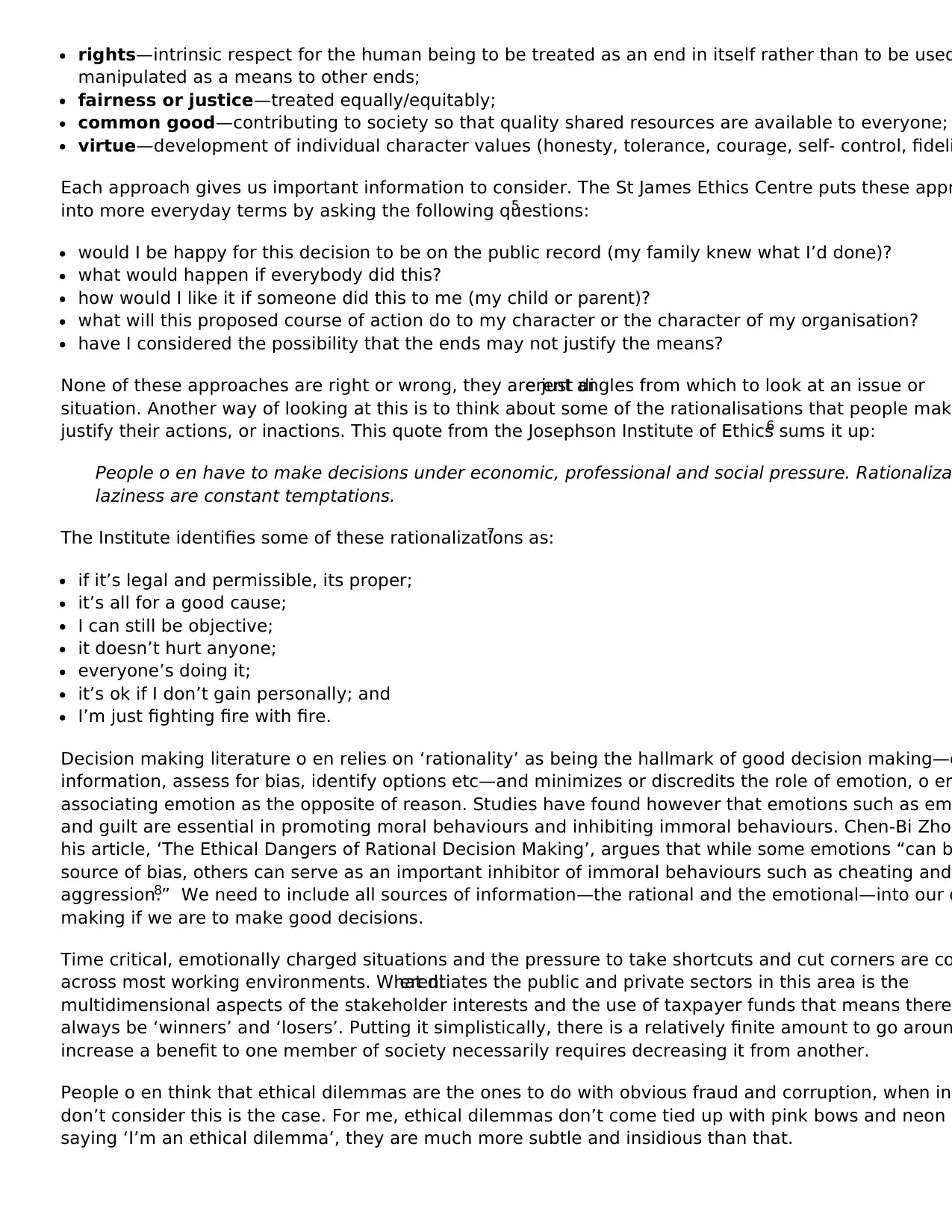
rights—intrinsic respect for the human being to be treated as an end in itself rather than to be used
manipulated as a means to other ends;
fairness or justice—treated equally/equitably;
common good—contributing to society so that quality shared resources are available to everyone;
virtue—development of individual character values (honesty, tolerance, courage, self- control, fideli
Each approach gives us important information to consider. The St James Ethics Centre puts these appr
into more everyday terms by asking the following questions:
would I be happy for this decision to be on the public record (my family knew what I’d done)?
what would happen if everybody did this?
how would I like it if someone did this to me (my child or parent)?
what will this proposed course of action do to my character or the character of my organisation?
have I considered the possibility that the ends may not justify the means?
None of these approaches are right or wrong, they are just dierent angles from which to look at an issue or
situation. Another way of looking at this is to think about some of the rationalisations that people make
justify their actions, or inactions. This quote from the Josephson Institute of Ethics sums it up:
People o en have to make decisions under economic, professional and social pressure. Rationaliza
laziness are constant temptations.
The Institute identifies some of these rationalizations as:
if it’s legal and permissible, its proper;
it’s all for a good cause;
I can still be objective;
it doesn’t hurt anyone;
everyone’s doing it;
it’s ok if I don’t gain personally; and
I’m just fighting fire with fire.
Decision making literature o en relies on ‘rationality’ as being the hallmark of good decision making—o
information, assess for bias, identify options etc—and minimizes or discredits the role of emotion, o en
associating emotion as the opposite of reason. Studies have found however that emotions such as em
and guilt are essential in promoting moral behaviours and inhibiting immoral behaviours. Chen-Bi Zhon
his article, ‘The Ethical Dangers of Rational Decision Making’, argues that while some emotions “can b
source of bias, others can serve as an important inhibitor of immoral behaviours such as cheating and
aggression.” We need to include all sources of information—the rational and the emotional—into our d
making if we are to make good decisions.
Time critical, emotionally charged situations and the pressure to take shortcuts and cut corners are co
across most working environments. What dierentiates the public and private sectors in this area is the
multidimensional aspects of the stakeholder interests and the use of taxpayer funds that means there
always be ‘winners’ and ‘losers’. Putting it simplistically, there is a relatively finite amount to go aroun
increase a benefit to one member of society necessarily requires decreasing it from another.
People o en think that ethical dilemmas are the ones to do with obvious fraud and corruption, when in
don’t consider this is the case. For me, ethical dilemmas don’t come tied up with pink bows and neon l
saying ‘I’m an ethical dilemma’, they are much more subtle and insidious than that.
5
6
7
8
manipulated as a means to other ends;
fairness or justice—treated equally/equitably;
common good—contributing to society so that quality shared resources are available to everyone;
virtue—development of individual character values (honesty, tolerance, courage, self- control, fideli
Each approach gives us important information to consider. The St James Ethics Centre puts these appr
into more everyday terms by asking the following questions:
would I be happy for this decision to be on the public record (my family knew what I’d done)?
what would happen if everybody did this?
how would I like it if someone did this to me (my child or parent)?
what will this proposed course of action do to my character or the character of my organisation?
have I considered the possibility that the ends may not justify the means?
None of these approaches are right or wrong, they are just dierent angles from which to look at an issue or
situation. Another way of looking at this is to think about some of the rationalisations that people make
justify their actions, or inactions. This quote from the Josephson Institute of Ethics sums it up:
People o en have to make decisions under economic, professional and social pressure. Rationaliza
laziness are constant temptations.
The Institute identifies some of these rationalizations as:
if it’s legal and permissible, its proper;
it’s all for a good cause;
I can still be objective;
it doesn’t hurt anyone;
everyone’s doing it;
it’s ok if I don’t gain personally; and
I’m just fighting fire with fire.
Decision making literature o en relies on ‘rationality’ as being the hallmark of good decision making—o
information, assess for bias, identify options etc—and minimizes or discredits the role of emotion, o en
associating emotion as the opposite of reason. Studies have found however that emotions such as em
and guilt are essential in promoting moral behaviours and inhibiting immoral behaviours. Chen-Bi Zhon
his article, ‘The Ethical Dangers of Rational Decision Making’, argues that while some emotions “can b
source of bias, others can serve as an important inhibitor of immoral behaviours such as cheating and
aggression.” We need to include all sources of information—the rational and the emotional—into our d
making if we are to make good decisions.
Time critical, emotionally charged situations and the pressure to take shortcuts and cut corners are co
across most working environments. What dierentiates the public and private sectors in this area is the
multidimensional aspects of the stakeholder interests and the use of taxpayer funds that means there
always be ‘winners’ and ‘losers’. Putting it simplistically, there is a relatively finite amount to go aroun
increase a benefit to one member of society necessarily requires decreasing it from another.
People o en think that ethical dilemmas are the ones to do with obvious fraud and corruption, when in
don’t consider this is the case. For me, ethical dilemmas don’t come tied up with pink bows and neon l
saying ‘I’m an ethical dilemma’, they are much more subtle and insidious than that.
5
6
7
8
⊘ This is a preview!⊘
Do you want full access?
Subscribe today to unlock all pages.

Trusted by 1+ million students worldwide
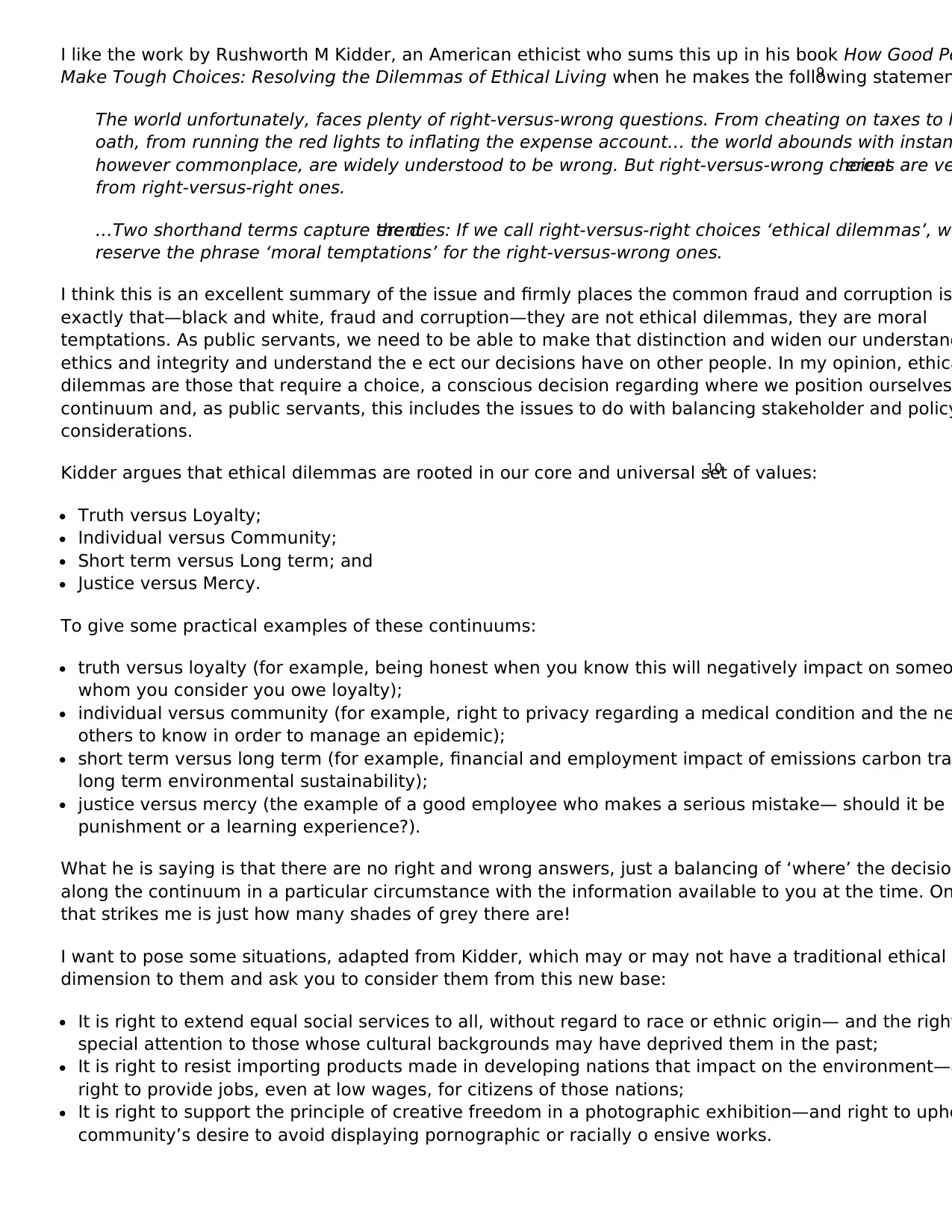
I like the work by Rushworth M Kidder, an American ethicist who sums this up in his book How Good Pe
Make Tough Choices: Resolving the Dilemmas of Ethical Living when he makes the following statemen
The world unfortunately, faces plenty of right-versus-wrong questions. From cheating on taxes to l
oath, from running the red lights to inflating the expense account… the world abounds with instan
however commonplace, are widely understood to be wrong. But right-versus-wrong choices are veerent
from right-versus-right ones.
…Two shorthand terms capture the dierences: If we call right-versus-right choices ‘ethical dilemmas’, we
reserve the phrase ‘moral temptations’ for the right-versus-wrong ones.
I think this is an excellent summary of the issue and firmly places the common fraud and corruption is
exactly that—black and white, fraud and corruption—they are not ethical dilemmas, they are moral
temptations. As public servants, we need to be able to make that distinction and widen our understand
ethics and integrity and understand the e ect our decisions have on other people. In my opinion, ethica
dilemmas are those that require a choice, a conscious decision regarding where we position ourselves
continuum and, as public servants, this includes the issues to do with balancing stakeholder and policy
considerations.
Kidder argues that ethical dilemmas are rooted in our core and universal set of values:
Truth versus Loyalty;
Individual versus Community;
Short term versus Long term; and
Justice versus Mercy.
To give some practical examples of these continuums:
truth versus loyalty (for example, being honest when you know this will negatively impact on someo
whom you consider you owe loyalty);
individual versus community (for example, right to privacy regarding a medical condition and the ne
others to know in order to manage an epidemic);
short term versus long term (for example, financial and employment impact of emissions carbon trad
long term environmental sustainability);
justice versus mercy (the example of a good employee who makes a serious mistake— should it be u
punishment or a learning experience?).
What he is saying is that there are no right and wrong answers, just a balancing of ‘where’ the decision
along the continuum in a particular circumstance with the information available to you at the time. On
that strikes me is just how many shades of grey there are!
I want to pose some situations, adapted from Kidder, which may or may not have a traditional ethical
dimension to them and ask you to consider them from this new base:
It is right to extend equal social services to all, without regard to race or ethnic origin— and the right
special attention to those whose cultural backgrounds may have deprived them in the past;
It is right to resist importing products made in developing nations that impact on the environment—a
right to provide jobs, even at low wages, for citizens of those nations;
It is right to support the principle of creative freedom in a photographic exhibition—and right to upho
community’s desire to avoid displaying pornographic or racially o ensive works.
9
10
Make Tough Choices: Resolving the Dilemmas of Ethical Living when he makes the following statemen
The world unfortunately, faces plenty of right-versus-wrong questions. From cheating on taxes to l
oath, from running the red lights to inflating the expense account… the world abounds with instan
however commonplace, are widely understood to be wrong. But right-versus-wrong choices are veerent
from right-versus-right ones.
…Two shorthand terms capture the dierences: If we call right-versus-right choices ‘ethical dilemmas’, we
reserve the phrase ‘moral temptations’ for the right-versus-wrong ones.
I think this is an excellent summary of the issue and firmly places the common fraud and corruption is
exactly that—black and white, fraud and corruption—they are not ethical dilemmas, they are moral
temptations. As public servants, we need to be able to make that distinction and widen our understand
ethics and integrity and understand the e ect our decisions have on other people. In my opinion, ethica
dilemmas are those that require a choice, a conscious decision regarding where we position ourselves
continuum and, as public servants, this includes the issues to do with balancing stakeholder and policy
considerations.
Kidder argues that ethical dilemmas are rooted in our core and universal set of values:
Truth versus Loyalty;
Individual versus Community;
Short term versus Long term; and
Justice versus Mercy.
To give some practical examples of these continuums:
truth versus loyalty (for example, being honest when you know this will negatively impact on someo
whom you consider you owe loyalty);
individual versus community (for example, right to privacy regarding a medical condition and the ne
others to know in order to manage an epidemic);
short term versus long term (for example, financial and employment impact of emissions carbon trad
long term environmental sustainability);
justice versus mercy (the example of a good employee who makes a serious mistake— should it be u
punishment or a learning experience?).
What he is saying is that there are no right and wrong answers, just a balancing of ‘where’ the decision
along the continuum in a particular circumstance with the information available to you at the time. On
that strikes me is just how many shades of grey there are!
I want to pose some situations, adapted from Kidder, which may or may not have a traditional ethical
dimension to them and ask you to consider them from this new base:
It is right to extend equal social services to all, without regard to race or ethnic origin— and the right
special attention to those whose cultural backgrounds may have deprived them in the past;
It is right to resist importing products made in developing nations that impact on the environment—a
right to provide jobs, even at low wages, for citizens of those nations;
It is right to support the principle of creative freedom in a photographic exhibition—and right to upho
community’s desire to avoid displaying pornographic or racially o ensive works.
9
10
Paraphrase This Document
Need a fresh take? Get an instant paraphrase of this document with our AI Paraphraser
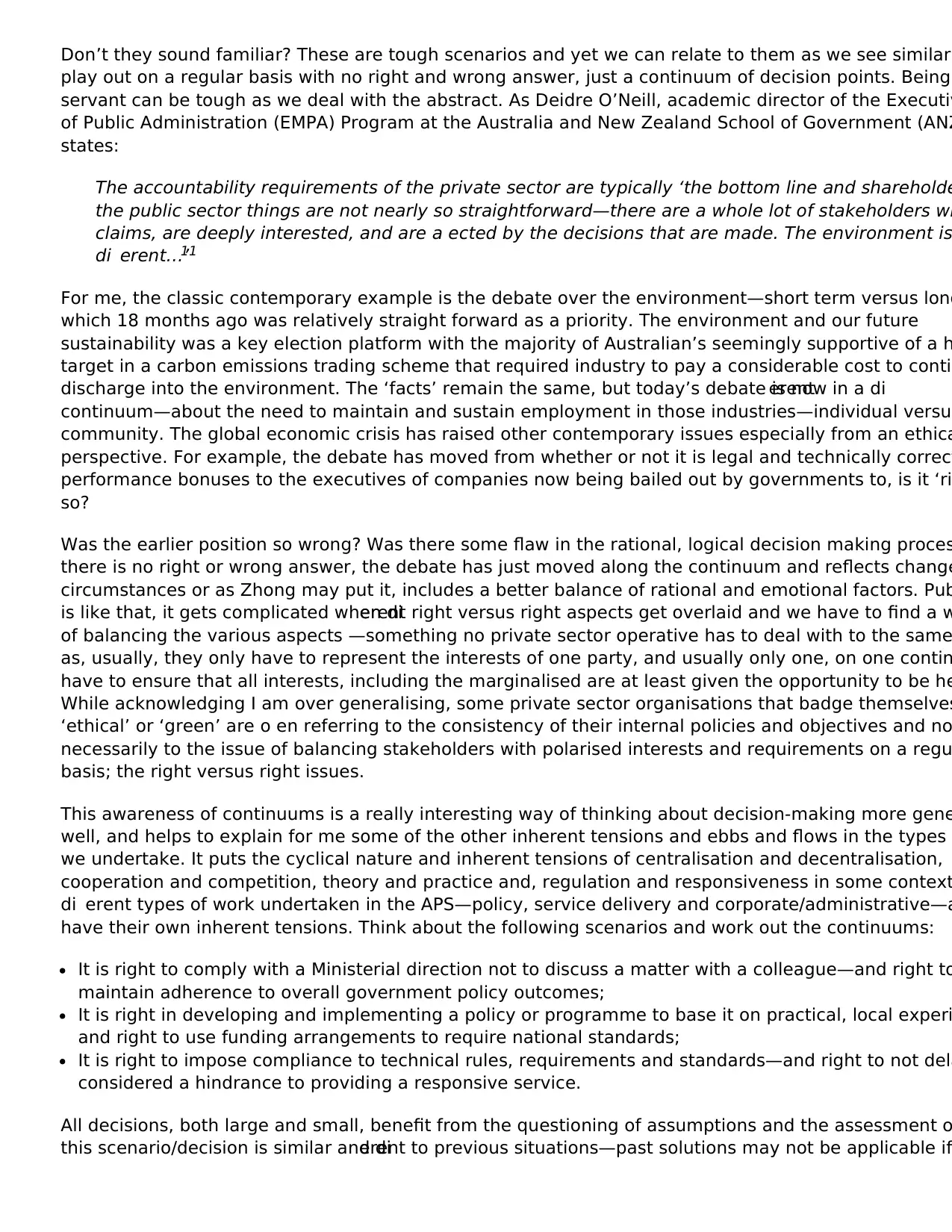
Don’t they sound familiar? These are tough scenarios and yet we can relate to them as we see similar
play out on a regular basis with no right and wrong answer, just a continuum of decision points. Being
servant can be tough as we deal with the abstract. As Deidre O’Neill, academic director of the Executiv
of Public Administration (EMPA) Program at the Australia and New Zealand School of Government (ANZ
states:
The accountability requirements of the private sector are typically ‘the bottom line and shareholde
the public sector things are not nearly so straightforward—there are a whole lot of stakeholders wh
claims, are deeply interested, and are a ected by the decisions that are made. The environment is
di erent…’
For me, the classic contemporary example is the debate over the environment—short term versus long
which 18 months ago was relatively straight forward as a priority. The environment and our future
sustainability was a key election platform with the majority of Australian’s seemingly supportive of a h
target in a carbon emissions trading scheme that required industry to pay a considerable cost to contin
discharge into the environment. The ‘facts’ remain the same, but today’s debate is now in a dierent
continuum—about the need to maintain and sustain employment in those industries—individual versus
community. The global economic crisis has raised other contemporary issues especially from an ethica
perspective. For example, the debate has moved from whether or not it is legal and technically correct
performance bonuses to the executives of companies now being bailed out by governments to, is it ‘ri
so?
Was the earlier position so wrong? Was there some flaw in the rational, logical decision making proces
there is no right or wrong answer, the debate has just moved along the continuum and reflects change
circumstances or as Zhong may put it, includes a better balance of rational and emotional factors. Pub
is like that, it gets complicated when dierent right versus right aspects get overlaid and we have to find a w
of balancing the various aspects —something no private sector operative has to deal with to the same
as, usually, they only have to represent the interests of one party, and usually only one, on one contin
have to ensure that all interests, including the marginalised are at least given the opportunity to be he
While acknowledging I am over generalising, some private sector organisations that badge themselves
‘ethical’ or ‘green’ are o en referring to the consistency of their internal policies and objectives and no
necessarily to the issue of balancing stakeholders with polarised interests and requirements on a regu
basis; the right versus right issues.
This awareness of continuums is a really interesting way of thinking about decision-making more gene
well, and helps to explain for me some of the other inherent tensions and ebbs and flows in the types o
we undertake. It puts the cyclical nature and inherent tensions of centralisation and decentralisation,
cooperation and competition, theory and practice and, regulation and responsiveness in some context
di erent types of work undertaken in the APS—policy, service delivery and corporate/administrative—a
have their own inherent tensions. Think about the following scenarios and work out the continuums:
It is right to comply with a Ministerial direction not to discuss a matter with a colleague—and right to
maintain adherence to overall government policy outcomes;
It is right in developing and implementing a policy or programme to base it on practical, local experi
and right to use funding arrangements to require national standards;
It is right to impose compliance to technical rules, requirements and standards—and right to not dela
considered a hindrance to providing a responsive service.
All decisions, both large and small, benefit from the questioning of assumptions and the assessment o
this scenario/decision is similar and dierent to previous situations—past solutions may not be applicable if
11
play out on a regular basis with no right and wrong answer, just a continuum of decision points. Being
servant can be tough as we deal with the abstract. As Deidre O’Neill, academic director of the Executiv
of Public Administration (EMPA) Program at the Australia and New Zealand School of Government (ANZ
states:
The accountability requirements of the private sector are typically ‘the bottom line and shareholde
the public sector things are not nearly so straightforward—there are a whole lot of stakeholders wh
claims, are deeply interested, and are a ected by the decisions that are made. The environment is
di erent…’
For me, the classic contemporary example is the debate over the environment—short term versus long
which 18 months ago was relatively straight forward as a priority. The environment and our future
sustainability was a key election platform with the majority of Australian’s seemingly supportive of a h
target in a carbon emissions trading scheme that required industry to pay a considerable cost to contin
discharge into the environment. The ‘facts’ remain the same, but today’s debate is now in a dierent
continuum—about the need to maintain and sustain employment in those industries—individual versus
community. The global economic crisis has raised other contemporary issues especially from an ethica
perspective. For example, the debate has moved from whether or not it is legal and technically correct
performance bonuses to the executives of companies now being bailed out by governments to, is it ‘ri
so?
Was the earlier position so wrong? Was there some flaw in the rational, logical decision making proces
there is no right or wrong answer, the debate has just moved along the continuum and reflects change
circumstances or as Zhong may put it, includes a better balance of rational and emotional factors. Pub
is like that, it gets complicated when dierent right versus right aspects get overlaid and we have to find a w
of balancing the various aspects —something no private sector operative has to deal with to the same
as, usually, they only have to represent the interests of one party, and usually only one, on one contin
have to ensure that all interests, including the marginalised are at least given the opportunity to be he
While acknowledging I am over generalising, some private sector organisations that badge themselves
‘ethical’ or ‘green’ are o en referring to the consistency of their internal policies and objectives and no
necessarily to the issue of balancing stakeholders with polarised interests and requirements on a regu
basis; the right versus right issues.
This awareness of continuums is a really interesting way of thinking about decision-making more gene
well, and helps to explain for me some of the other inherent tensions and ebbs and flows in the types o
we undertake. It puts the cyclical nature and inherent tensions of centralisation and decentralisation,
cooperation and competition, theory and practice and, regulation and responsiveness in some context
di erent types of work undertaken in the APS—policy, service delivery and corporate/administrative—a
have their own inherent tensions. Think about the following scenarios and work out the continuums:
It is right to comply with a Ministerial direction not to discuss a matter with a colleague—and right to
maintain adherence to overall government policy outcomes;
It is right in developing and implementing a policy or programme to base it on practical, local experi
and right to use funding arrangements to require national standards;
It is right to impose compliance to technical rules, requirements and standards—and right to not dela
considered a hindrance to providing a responsive service.
All decisions, both large and small, benefit from the questioning of assumptions and the assessment o
this scenario/decision is similar and dierent to previous situations—past solutions may not be applicable if
11
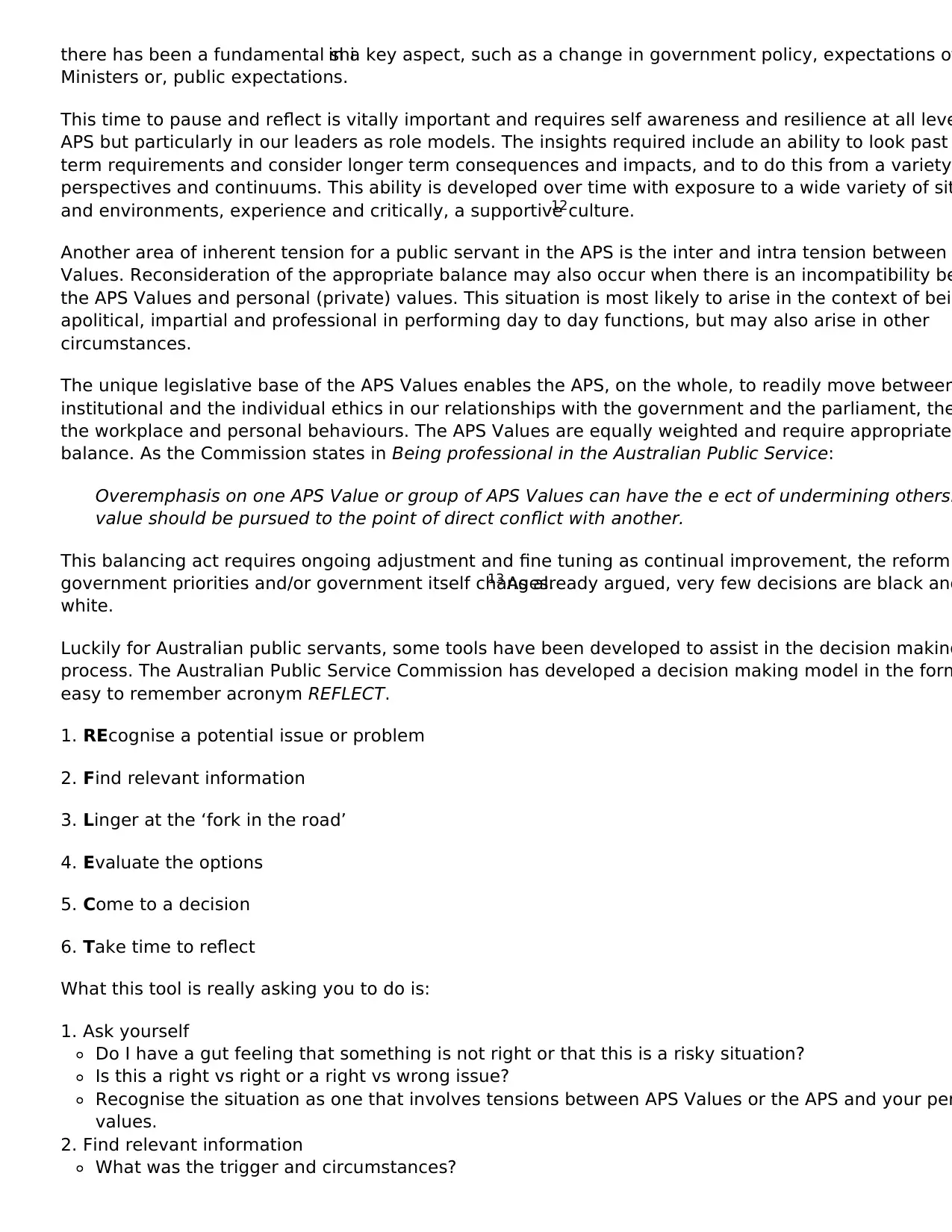
there has been a fundamental shiin a key aspect, such as a change in government policy, expectations of
Ministers or, public expectations.
This time to pause and reflect is vitally important and requires self awareness and resilience at all leve
APS but particularly in our leaders as role models. The insights required include an ability to look past
term requirements and consider longer term consequences and impacts, and to do this from a variety
perspectives and continuums. This ability is developed over time with exposure to a wide variety of sit
and environments, experience and critically, a supportive culture.
Another area of inherent tension for a public servant in the APS is the inter and intra tension between
Values. Reconsideration of the appropriate balance may also occur when there is an incompatibility be
the APS Values and personal (private) values. This situation is most likely to arise in the context of bein
apolitical, impartial and professional in performing day to day functions, but may also arise in other
circumstances.
The unique legislative base of the APS Values enables the APS, on the whole, to readily move between
institutional and the individual ethics in our relationships with the government and the parliament, the
the workplace and personal behaviours. The APS Values are equally weighted and require appropriate
balance. As the Commission states in Being professional in the Australian Public Service:
Overemphasis on one APS Value or group of APS Values can have the e ect of undermining others.
value should be pursued to the point of direct conflict with another.
This balancing act requires ongoing adjustment and fine tuning as continual improvement, the reform
government priorities and/or government itself changes.As already argued, very few decisions are black and
white.
Luckily for Australian public servants, some tools have been developed to assist in the decision making
process. The Australian Public Service Commission has developed a decision making model in the form
easy to remember acronym REFLECT.
1. REcognise a potential issue or problem
2. Find relevant information
3. Linger at the ‘fork in the road’
4. Evaluate the options
5. Come to a decision
6. Take time to reflect
What this tool is really asking you to do is:
1. Ask yourself
Do I have a gut feeling that something is not right or that this is a risky situation?
Is this a right vs right or a right vs wrong issue?
Recognise the situation as one that involves tensions between APS Values or the APS and your per
values.
2. Find relevant information
What was the trigger and circumstances?
12
13
Ministers or, public expectations.
This time to pause and reflect is vitally important and requires self awareness and resilience at all leve
APS but particularly in our leaders as role models. The insights required include an ability to look past
term requirements and consider longer term consequences and impacts, and to do this from a variety
perspectives and continuums. This ability is developed over time with exposure to a wide variety of sit
and environments, experience and critically, a supportive culture.
Another area of inherent tension for a public servant in the APS is the inter and intra tension between
Values. Reconsideration of the appropriate balance may also occur when there is an incompatibility be
the APS Values and personal (private) values. This situation is most likely to arise in the context of bein
apolitical, impartial and professional in performing day to day functions, but may also arise in other
circumstances.
The unique legislative base of the APS Values enables the APS, on the whole, to readily move between
institutional and the individual ethics in our relationships with the government and the parliament, the
the workplace and personal behaviours. The APS Values are equally weighted and require appropriate
balance. As the Commission states in Being professional in the Australian Public Service:
Overemphasis on one APS Value or group of APS Values can have the e ect of undermining others.
value should be pursued to the point of direct conflict with another.
This balancing act requires ongoing adjustment and fine tuning as continual improvement, the reform
government priorities and/or government itself changes.As already argued, very few decisions are black and
white.
Luckily for Australian public servants, some tools have been developed to assist in the decision making
process. The Australian Public Service Commission has developed a decision making model in the form
easy to remember acronym REFLECT.
1. REcognise a potential issue or problem
2. Find relevant information
3. Linger at the ‘fork in the road’
4. Evaluate the options
5. Come to a decision
6. Take time to reflect
What this tool is really asking you to do is:
1. Ask yourself
Do I have a gut feeling that something is not right or that this is a risky situation?
Is this a right vs right or a right vs wrong issue?
Recognise the situation as one that involves tensions between APS Values or the APS and your per
values.
2. Find relevant information
What was the trigger and circumstances?
12
13
⊘ This is a preview!⊘
Do you want full access?
Subscribe today to unlock all pages.

Trusted by 1+ million students worldwide
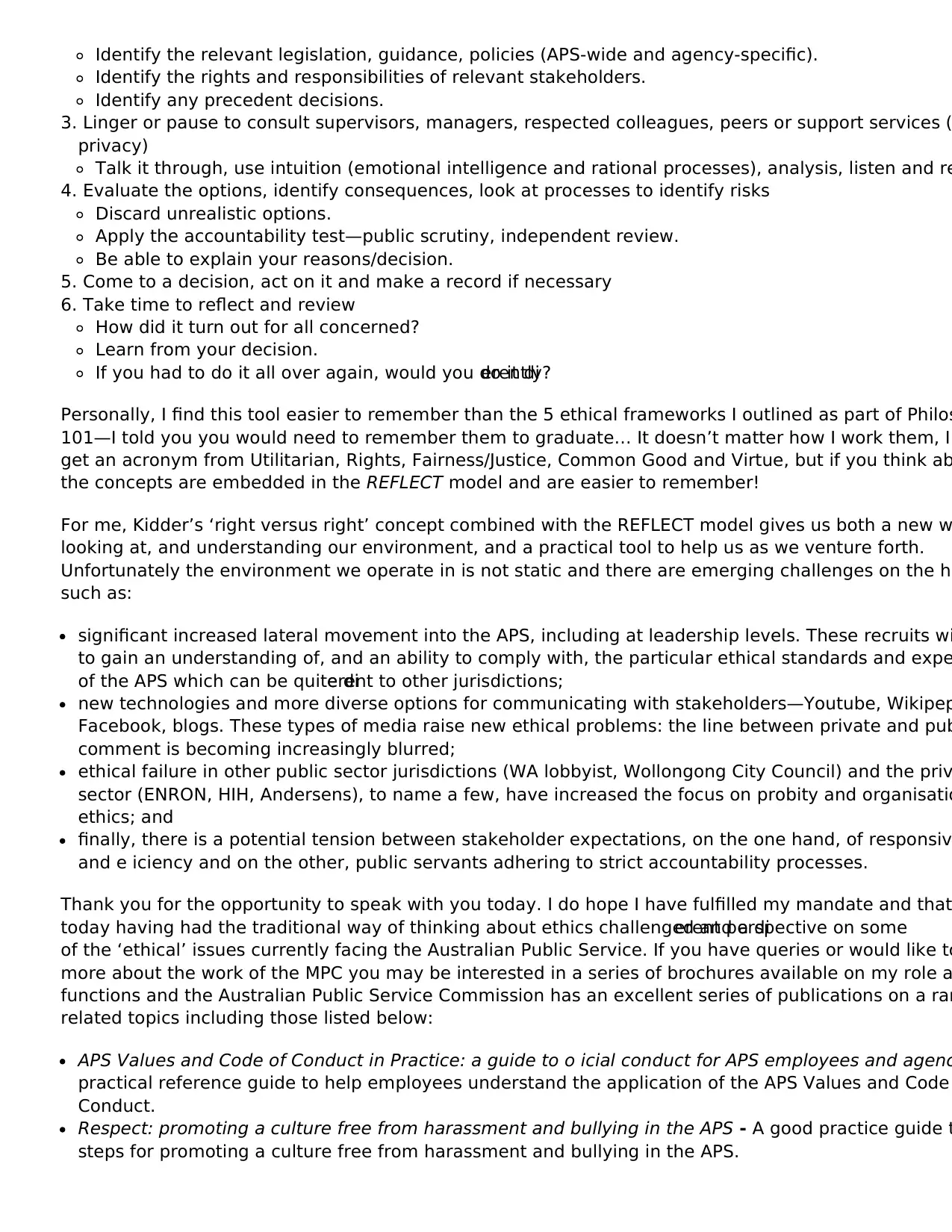
Identify the relevant legislation, guidance, policies (APS-wide and agency-specific).
Identify the rights and responsibilities of relevant stakeholders.
Identify any precedent decisions.
3. Linger or pause to consult supervisors, managers, respected colleagues, peers or support services (
privacy)
Talk it through, use intuition (emotional intelligence and rational processes), analysis, listen and re
4. Evaluate the options, identify consequences, look at processes to identify risks
Discard unrealistic options.
Apply the accountability test—public scrutiny, independent review.
Be able to explain your reasons/decision.
5. Come to a decision, act on it and make a record if necessary
6. Take time to reflect and review
How did it turn out for all concerned?
Learn from your decision.
If you had to do it all over again, would you do it dierently?
Personally, I find this tool easier to remember than the 5 ethical frameworks I outlined as part of Philos
101—I told you you would need to remember them to graduate… It doesn’t matter how I work them, I
get an acronym from Utilitarian, Rights, Fairness/Justice, Common Good and Virtue, but if you think ab
the concepts are embedded in the REFLECT model and are easier to remember!
For me, Kidder’s ‘right versus right’ concept combined with the REFLECT model gives us both a new w
looking at, and understanding our environment, and a practical tool to help us as we venture forth.
Unfortunately the environment we operate in is not static and there are emerging challenges on the ho
such as:
significant increased lateral movement into the APS, including at leadership levels. These recruits wi
to gain an understanding of, and an ability to comply with, the particular ethical standards and expe
of the APS which can be quite dierent to other jurisdictions;
new technologies and more diverse options for communicating with stakeholders—Youtube, Wikipep
Facebook, blogs. These types of media raise new ethical problems: the line between private and pub
comment is becoming increasingly blurred;
ethical failure in other public sector jurisdictions (WA lobbyist, Wollongong City Council) and the priv
sector (ENRON, HIH, Andersens), to name a few, have increased the focus on probity and organisatio
ethics; and
finally, there is a potential tension between stakeholder expectations, on the one hand, of responsiv
and e iciency and on the other, public servants adhering to strict accountability processes.
Thank you for the opportunity to speak with you today. I do hope I have fulfilled my mandate and that
today having had the traditional way of thinking about ethics challenged and a dierent perspective on some
of the ‘ethical’ issues currently facing the Australian Public Service. If you have queries or would like to
more about the work of the MPC you may be interested in a series of brochures available on my role a
functions and the Australian Public Service Commission has an excellent series of publications on a ran
related topics including those listed below:
APS Values and Code of Conduct in Practice: a guide to o icial conduct for APS employees and agenc
practical reference guide to help employees understand the application of the APS Values and Code
Conduct.
Respect: promoting a culture free from harassment and bullying in the APS - A good practice guide t
steps for promoting a culture free from harassment and bullying in the APS.
Identify the rights and responsibilities of relevant stakeholders.
Identify any precedent decisions.
3. Linger or pause to consult supervisors, managers, respected colleagues, peers or support services (
privacy)
Talk it through, use intuition (emotional intelligence and rational processes), analysis, listen and re
4. Evaluate the options, identify consequences, look at processes to identify risks
Discard unrealistic options.
Apply the accountability test—public scrutiny, independent review.
Be able to explain your reasons/decision.
5. Come to a decision, act on it and make a record if necessary
6. Take time to reflect and review
How did it turn out for all concerned?
Learn from your decision.
If you had to do it all over again, would you do it dierently?
Personally, I find this tool easier to remember than the 5 ethical frameworks I outlined as part of Philos
101—I told you you would need to remember them to graduate… It doesn’t matter how I work them, I
get an acronym from Utilitarian, Rights, Fairness/Justice, Common Good and Virtue, but if you think ab
the concepts are embedded in the REFLECT model and are easier to remember!
For me, Kidder’s ‘right versus right’ concept combined with the REFLECT model gives us both a new w
looking at, and understanding our environment, and a practical tool to help us as we venture forth.
Unfortunately the environment we operate in is not static and there are emerging challenges on the ho
such as:
significant increased lateral movement into the APS, including at leadership levels. These recruits wi
to gain an understanding of, and an ability to comply with, the particular ethical standards and expe
of the APS which can be quite dierent to other jurisdictions;
new technologies and more diverse options for communicating with stakeholders—Youtube, Wikipep
Facebook, blogs. These types of media raise new ethical problems: the line between private and pub
comment is becoming increasingly blurred;
ethical failure in other public sector jurisdictions (WA lobbyist, Wollongong City Council) and the priv
sector (ENRON, HIH, Andersens), to name a few, have increased the focus on probity and organisatio
ethics; and
finally, there is a potential tension between stakeholder expectations, on the one hand, of responsiv
and e iciency and on the other, public servants adhering to strict accountability processes.
Thank you for the opportunity to speak with you today. I do hope I have fulfilled my mandate and that
today having had the traditional way of thinking about ethics challenged and a dierent perspective on some
of the ‘ethical’ issues currently facing the Australian Public Service. If you have queries or would like to
more about the work of the MPC you may be interested in a series of brochures available on my role a
functions and the Australian Public Service Commission has an excellent series of publications on a ran
related topics including those listed below:
APS Values and Code of Conduct in Practice: a guide to o icial conduct for APS employees and agenc
practical reference guide to help employees understand the application of the APS Values and Code
Conduct.
Respect: promoting a culture free from harassment and bullying in the APS - A good practice guide t
steps for promoting a culture free from harassment and bullying in the APS.
Paraphrase This Document
Need a fresh take? Get an instant paraphrase of this document with our AI Paraphraser
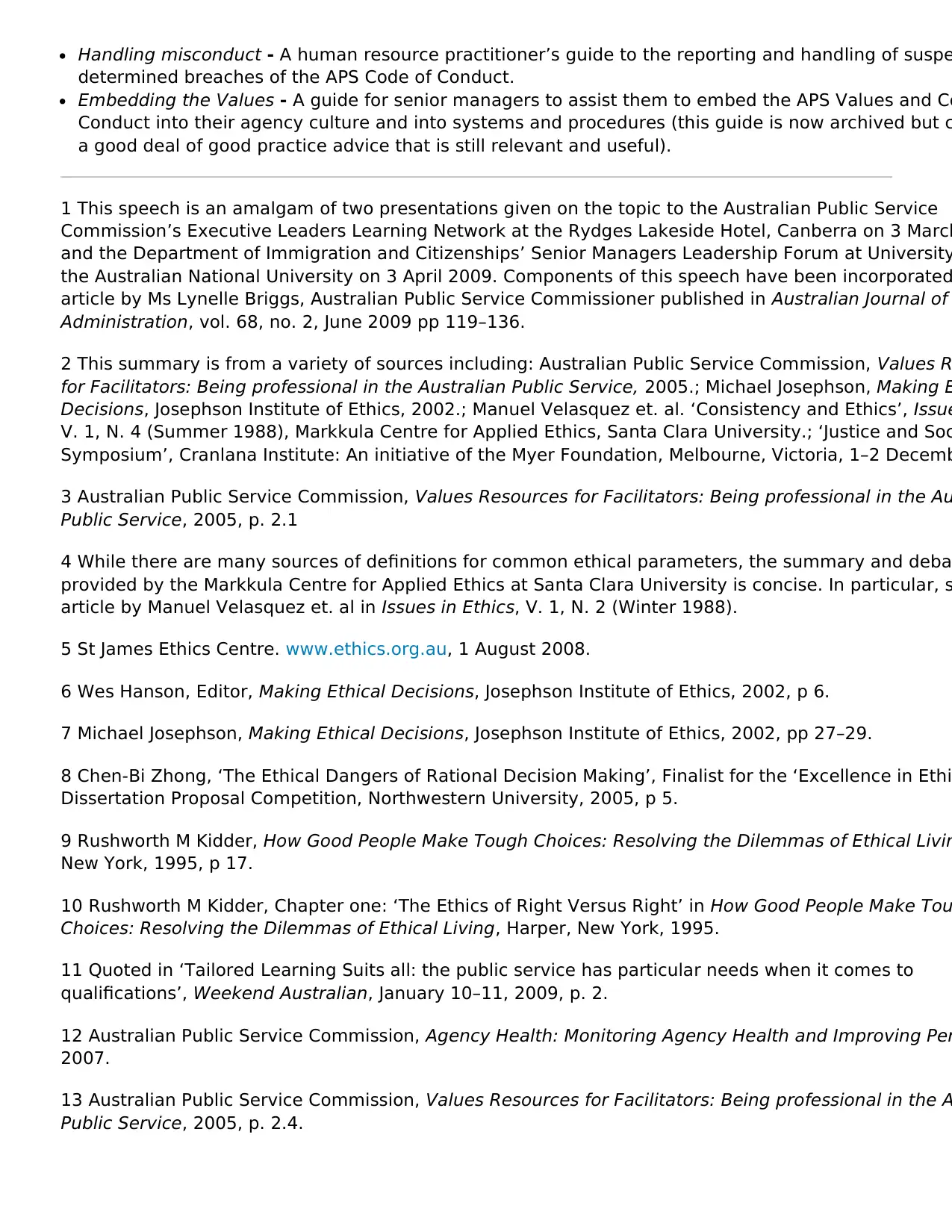
Handling misconduct - A human resource practitioner’s guide to the reporting and handling of suspe
determined breaches of the APS Code of Conduct.
Embedding the Values - A guide for senior managers to assist them to embed the APS Values and Co
Conduct into their agency culture and into systems and procedures (this guide is now archived but c
a good deal of good practice advice that is still relevant and useful).
1 This speech is an amalgam of two presentations given on the topic to the Australian Public Service
Commission’s Executive Leaders Learning Network at the Rydges Lakeside Hotel, Canberra on 3 March
and the Department of Immigration and Citizenships’ Senior Managers Leadership Forum at University
the Australian National University on 3 April 2009. Components of this speech have been incorporated
article by Ms Lynelle Briggs, Australian Public Service Commissioner published in Australian Journal of
Administration, vol. 68, no. 2, June 2009 pp 119–136.
2 This summary is from a variety of sources including: Australian Public Service Commission, Values R
for Facilitators: Being professional in the Australian Public Service, 2005.; Michael Josephson, Making E
Decisions, Josephson Institute of Ethics, 2002.; Manuel Velasquez et. al. ‘Consistency and Ethics’, Issue
V. 1, N. 4 (Summer 1988), Markkula Centre for Applied Ethics, Santa Clara University.; ‘Justice and Soc
Symposium’, Cranlana Institute: An initiative of the Myer Foundation, Melbourne, Victoria, 1–2 Decemb
3 Australian Public Service Commission, Values Resources for Facilitators: Being professional in the Au
Public Service, 2005, p. 2.1
4 While there are many sources of definitions for common ethical parameters, the summary and deba
provided by the Markkula Centre for Applied Ethics at Santa Clara University is concise. In particular, s
article by Manuel Velasquez et. al in Issues in Ethics, V. 1, N. 2 (Winter 1988).
5 St James Ethics Centre. www.ethics.org.au, 1 August 2008.
6 Wes Hanson, Editor, Making Ethical Decisions, Josephson Institute of Ethics, 2002, p 6.
7 Michael Josephson, Making Ethical Decisions, Josephson Institute of Ethics, 2002, pp 27–29.
8 Chen-Bi Zhong, ‘The Ethical Dangers of Rational Decision Making’, Finalist for the ‘Excellence in Ethic
Dissertation Proposal Competition, Northwestern University, 2005, p 5.
9 Rushworth M Kidder, How Good People Make Tough Choices: Resolving the Dilemmas of Ethical Livin
New York, 1995, p 17.
10 Rushworth M Kidder, Chapter one: ‘The Ethics of Right Versus Right’ in How Good People Make Tou
Choices: Resolving the Dilemmas of Ethical Living, Harper, New York, 1995.
11 Quoted in ‘Tailored Learning Suits all: the public service has particular needs when it comes to
qualifications’, Weekend Australian, January 10–11, 2009, p. 2.
12 Australian Public Service Commission, Agency Health: Monitoring Agency Health and Improving Per
2007.
13 Australian Public Service Commission, Values Resources for Facilitators: Being professional in the A
Public Service, 2005, p. 2.4.
determined breaches of the APS Code of Conduct.
Embedding the Values - A guide for senior managers to assist them to embed the APS Values and Co
Conduct into their agency culture and into systems and procedures (this guide is now archived but c
a good deal of good practice advice that is still relevant and useful).
1 This speech is an amalgam of two presentations given on the topic to the Australian Public Service
Commission’s Executive Leaders Learning Network at the Rydges Lakeside Hotel, Canberra on 3 March
and the Department of Immigration and Citizenships’ Senior Managers Leadership Forum at University
the Australian National University on 3 April 2009. Components of this speech have been incorporated
article by Ms Lynelle Briggs, Australian Public Service Commissioner published in Australian Journal of
Administration, vol. 68, no. 2, June 2009 pp 119–136.
2 This summary is from a variety of sources including: Australian Public Service Commission, Values R
for Facilitators: Being professional in the Australian Public Service, 2005.; Michael Josephson, Making E
Decisions, Josephson Institute of Ethics, 2002.; Manuel Velasquez et. al. ‘Consistency and Ethics’, Issue
V. 1, N. 4 (Summer 1988), Markkula Centre for Applied Ethics, Santa Clara University.; ‘Justice and Soc
Symposium’, Cranlana Institute: An initiative of the Myer Foundation, Melbourne, Victoria, 1–2 Decemb
3 Australian Public Service Commission, Values Resources for Facilitators: Being professional in the Au
Public Service, 2005, p. 2.1
4 While there are many sources of definitions for common ethical parameters, the summary and deba
provided by the Markkula Centre for Applied Ethics at Santa Clara University is concise. In particular, s
article by Manuel Velasquez et. al in Issues in Ethics, V. 1, N. 2 (Winter 1988).
5 St James Ethics Centre. www.ethics.org.au, 1 August 2008.
6 Wes Hanson, Editor, Making Ethical Decisions, Josephson Institute of Ethics, 2002, p 6.
7 Michael Josephson, Making Ethical Decisions, Josephson Institute of Ethics, 2002, pp 27–29.
8 Chen-Bi Zhong, ‘The Ethical Dangers of Rational Decision Making’, Finalist for the ‘Excellence in Ethic
Dissertation Proposal Competition, Northwestern University, 2005, p 5.
9 Rushworth M Kidder, How Good People Make Tough Choices: Resolving the Dilemmas of Ethical Livin
New York, 1995, p 17.
10 Rushworth M Kidder, Chapter one: ‘The Ethics of Right Versus Right’ in How Good People Make Tou
Choices: Resolving the Dilemmas of Ethical Living, Harper, New York, 1995.
11 Quoted in ‘Tailored Learning Suits all: the public service has particular needs when it comes to
qualifications’, Weekend Australian, January 10–11, 2009, p. 2.
12 Australian Public Service Commission, Agency Health: Monitoring Agency Health and Improving Per
2007.
13 Australian Public Service Commission, Values Resources for Facilitators: Being professional in the A
Public Service, 2005, p. 2.4.
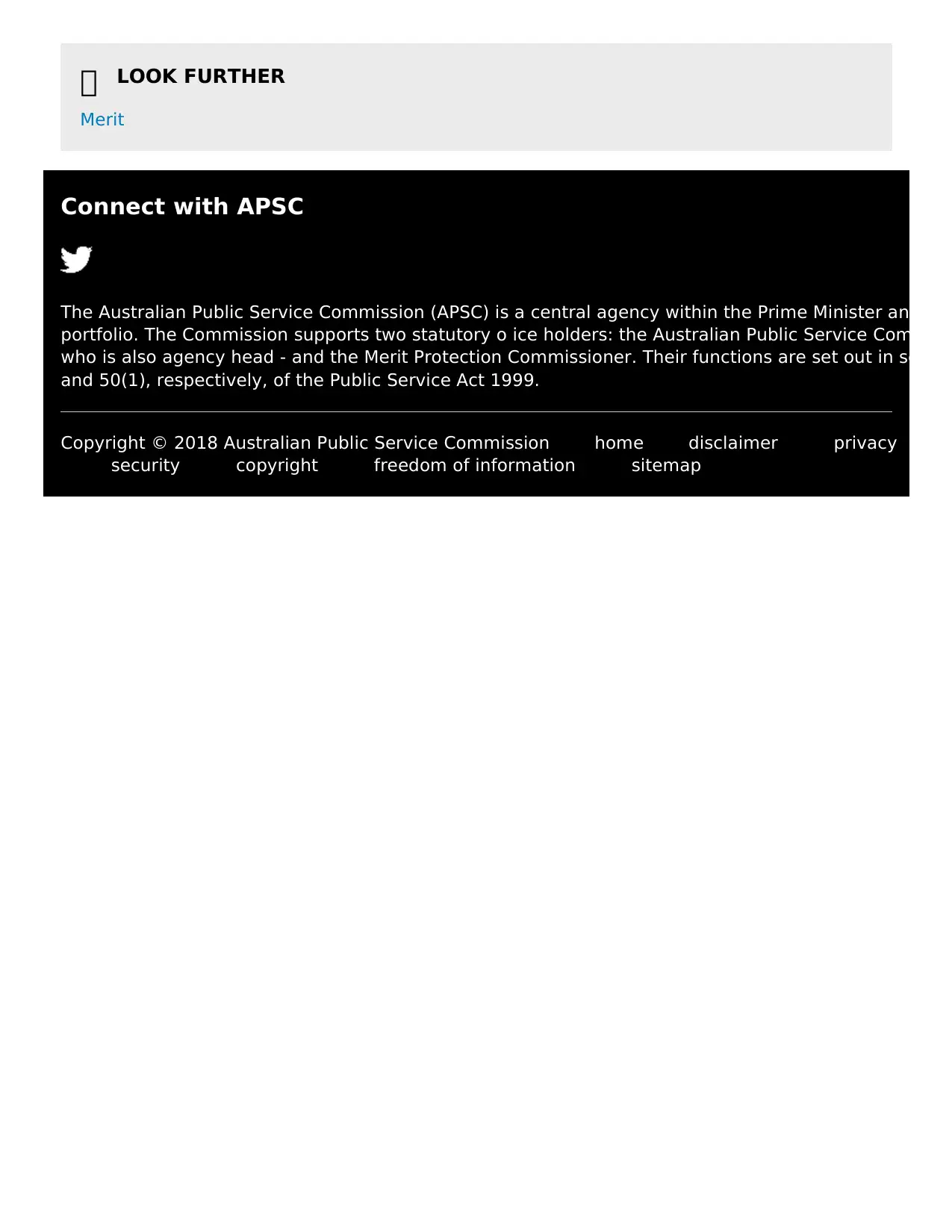
LOOK FURTHER
Merit
Connect with APSC
The Australian Public Service Commission (APSC) is a central agency within the Prime Minister and Cab
portfolio. The Commission supports two statutory o ice holders: the Australian Public Service Commiss
who is also agency head - and the Merit Protection Commissioner. Their functions are set out in section
and 50(1), respectively, of the Public Service Act 1999.
Copyright © 2018 Australian Public Service Commission home disclaimer privacy
security copyright freedom of information sitemap
Merit
Connect with APSC
The Australian Public Service Commission (APSC) is a central agency within the Prime Minister and Cab
portfolio. The Commission supports two statutory o ice holders: the Australian Public Service Commiss
who is also agency head - and the Merit Protection Commissioner. Their functions are set out in section
and 50(1), respectively, of the Public Service Act 1999.
Copyright © 2018 Australian Public Service Commission home disclaimer privacy
security copyright freedom of information sitemap
⊘ This is a preview!⊘
Do you want full access?
Subscribe today to unlock all pages.

Trusted by 1+ million students worldwide
1 out of 9
Related Documents
Your All-in-One AI-Powered Toolkit for Academic Success.
+13062052269
info@desklib.com
Available 24*7 on WhatsApp / Email
![[object Object]](/_next/static/media/star-bottom.7253800d.svg)
Unlock your academic potential
Copyright © 2020–2025 A2Z Services. All Rights Reserved. Developed and managed by ZUCOL.




